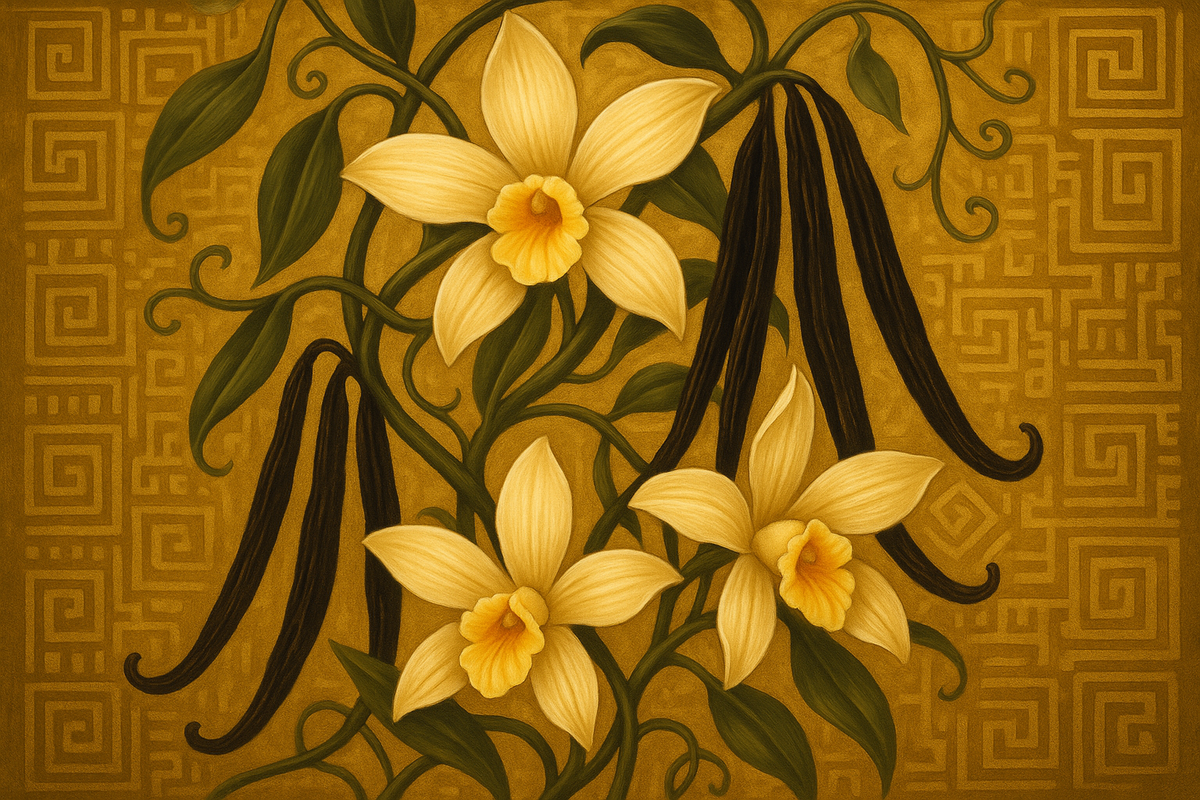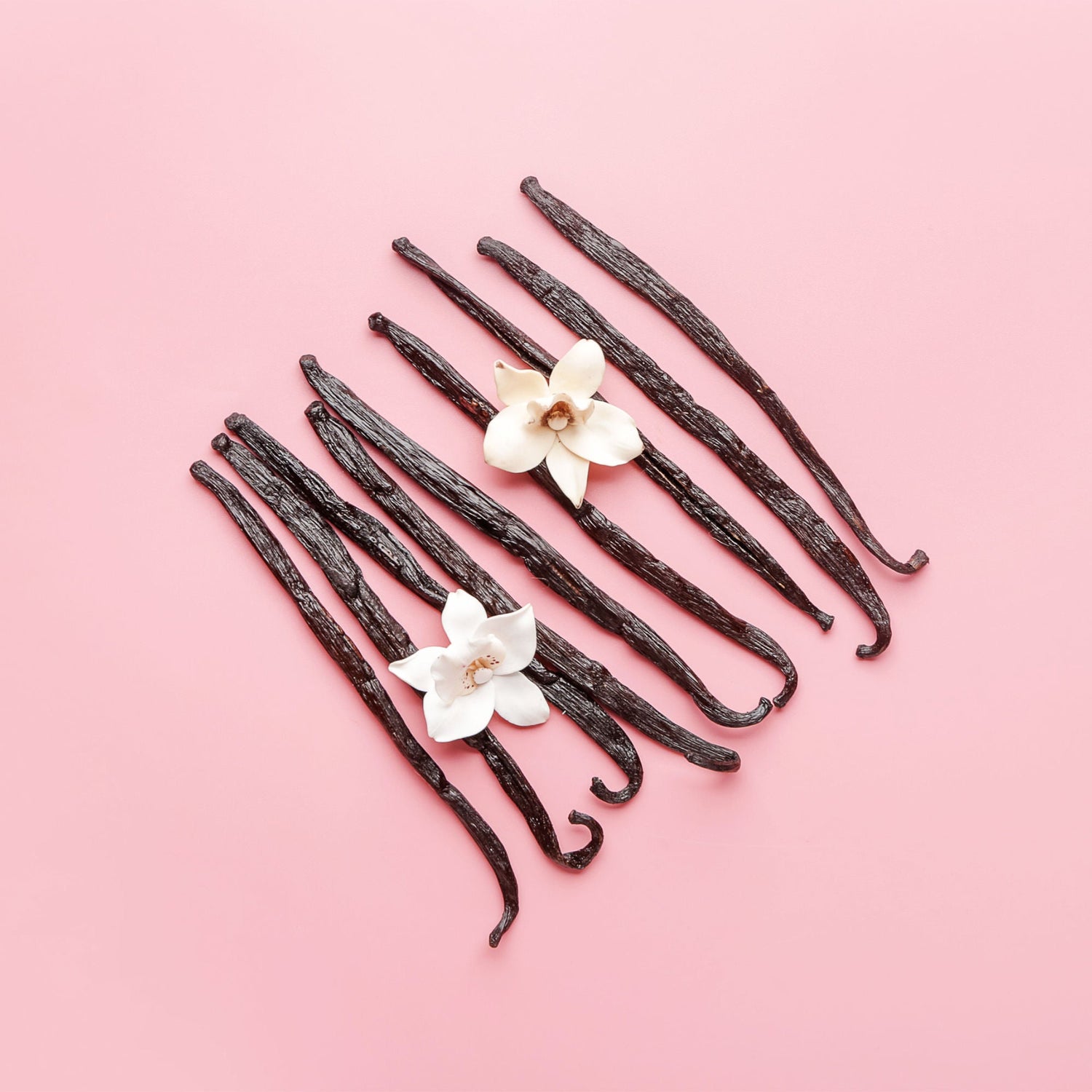
Vanilla: From the Aztecs’ Black Gold to Our Modern Kitchens
|
|
Time to read 8 min

Grand Cru Madagascar vanilla from the most prestigious plantations in Madagascar. Our...
|
|
Time to read 8 min
The extraordinary story of the world’s most precious spice
When you open a vanilla bean and that captivating aroma escapes, you’re holding the culmination of a centuries-old story. This simple brown pod, unassuming at first glance, actually holds one of the most fascinating tales in the culinary world: a sacred spice that became universal, a monopoly broken by the ingenuity of a teenager, and a prized aroma now rivaling gold in value.
The story of vanilla begins more than a thousand years ago in the humid tropical forests of the Gulf of Mexico. It’s there, between Veracruz and Oaxaca, that Vanilla planifolia grows naturally—a climbing orchid with discreet greenish flowers but extraordinarily fragrant fruit.
The Totonac people, indigenous to this region, were the first to domesticate this mysterious plant around the 12th century. For them, vanilla was more than just a spice—it was a gift from the gods. According to their legend, Princess Xanat, forbidden to love a mortal, transformed into a vanilla orchid so she could finally unite with her beloved. This romantic story explains why they named the spice "xanat," a term that means "hidden flower."
When the Aztecs expanded their empire, they discovered this aromatic marvel and quickly integrated it into their sophisticated culture. They called it "tlilxochitl," literally "black flower," in reference to the dark color the pods take on after drying.
Emperor Moctezuma II made vanilla one of the secret ingredients in his favorite drink: "xocolatl," a blend of cacao, vanilla, honey, and spices that we now consider the ancestor of hot chocolate. Reserved for the elite, this beverage was served in golden cups and believed to have aphrodisiac and invigorating properties.
In 1520, Hernán Cortés probably had no idea that by bringing a few vanilla beans back to Spain, he was introducing what would become the world’s most popular flavor. The Spanish conquistadors, initially skeptical of this “black spice” with an aroma so different from what they knew, were quickly won over by its sophisticated bouquet.
Spain jealously guarded the secret of vanilla for nearly a century, making it a royal monopoly. Vanilla was so valuable that it was sometimes used as currency in major trade transactions.
In the 17th century, vanilla began to spread through European courts. Louis XIV of France fell under the spell of this exotic spice and asked his chefs to include it in royal desserts. This led to the creation of the first vanilla ice creams and custards in European history.
Thomas Jefferson, during his time in France as ambassador, also discovered vanilla and helped introduce it to North America. He even wrote the first vanilla ice cream recipe for the American continent.
For more than three centuries after its discovery by Europeans, Mexico maintained an absolute monopoly on vanilla production. The reason was simple yet fascinating: in its natural habitat, vanilla can only be pollinated by a specific bee, the Melipona beecheii, a small, stingless bee native to the Mexican forests.
All attempts to cultivate vanilla in other tropical regions failed miserably. The plants would grow and bloom, but never produced pods. European botanists were baffled by this botanical mystery.
History took a turn on May 20, 1841, thanks to a 12-year-old boy named Edmond Albius. Born into slavery on the island of Réunion (then called Bourbon Island), this young boy often accompanied his master, Ferréol Bellier-Beaumont, a passionate botanist desperately trying to make his vanilla plants thrive.
Through careful observation and brilliant intuition, Edmond discovered that the membrane separating the male and female reproductive organs of the vanilla flower prevented natural pollination. With a simple orange thorn, he gently lifted this membrane and brought the reproductive organs into contact. Thus, the first artificial pollination of vanilla was born.
This technique, called “vanilla marriage,” revolutionized the global industry. It made it possible to grow vanilla in all suitable tropical regions, permanently ending the Mexican monopoly.
Réunion was the first to benefit from Edmond Albius’s discovery, but it was neighboring Madagascar that quickly became the world leader in vanilla production. The climate on Madagascar’s east coast, with its regular cyclones and rich volcanic soil, proved ideal for vanilla cultivation.
Today, Madagascar produces about 80% of the world’s vanilla. Bourbon vanilla (a designation that includes Madagascar, Réunion, and the Comoros) is considered the global quality benchmark, with a complex aroma profile blending creamy, spicy, and slightly woody notes.
Indonesia has become the world’s second-largest producer, offering vanilla with smokier and less sweet notes than Bourbon vanilla.
Tahiti produces a unique vanilla (Vanilla tahitensis) with floral and fruity notes, highly prized in fine pastry-making.
Uganda is developing a growing vanilla production with distinctly spicy notes.
Mexico, the historical birthplace, still maintains high-quality artisanal production, sought after by connoisseurs for its authenticity.
Growing vanilla requires extraordinary patience and expertise. The vanilla vine takes three years to bloom, and each flower opens for only a few hours early in the morning. Producers must hand-pollinate each flower, one by one, at sunrise.
A single vine can bear up to 10 clusters of flowers, and each cluster can have 20 flowers. But only 10 to 12 flowers per cluster are usually pollinated to avoid exhausting the plant. The pods then take 8 to 9 months to reach maturity.
The transformation of green, scentless pods into a fragrant spice is a true art passed down from generation to generation:
Scalding: Fresh beans are plunged into hot water (149°F) for 2 to 3 minutes to stop maturation and trigger enzymatic reactions.
Steaming: Wrapped in wool blankets, the pods “sweat” for 12 to 14 hours in their own vapors.
Sun-drying: Spread out on mats, the beans dry under the tropical sun for several weeks, developing their signature brown color.
Shaded drying: Final stage lasting 1 to 3 months in dry, well-ventilated areas.
Aging: The pods are stored in wooden trunks for 6 to 8 months to fully develop their aromas.
The aroma of vanilla comes mainly from vanillin (4-hydroxy-3-methoxybenzaldehyde), but a natural vanilla bean contains more than 250 different aromatic compounds! This complexity explains why artificial vanilla, based solely on synthetic vanillin, can’t reproduce the richness of natural vanilla.
Among these secondary compounds are vanillic acid, vanillyl alcohol, p-hydroxybenzaldehyde acid, and many esters that contribute fruity, floral, or spicy notes depending on the terroir.
In response to growing global demand and high prices for natural vanilla, the industry has developed several methods for producing synthetic vanillin:
Today, 99% of the vanillin consumed worldwide is synthetic, reserving natural vanilla for premium applications.
A quality bean should be:
The quality classifications (Gourmet, Prime, TK) indicate the moisture content and visual appearance of the beans.
For infusions: Split the pod, scrape out the seeds, and steep everything in hot milk, cream, or syrup. Steeping time ranges from 15 minutes to several hours, depending on the desired intensity.
In baking: Add the scraped seeds directly into doughs, creams, and batters. The tiny black specks are the hallmark of real vanilla.
For cold preparations: Let it steep longer, as the flavors develop more slowly when cold.
Storage and Reuse: A bean used for infusion can be rinsed, dried, and reused to flavor sugar or alcohol.
Vanilla pairs harmoniously with:
The vanilla market is one of the most volatile in the spice world. Prices can fluctuate tenfold from year to year, influenced by:
In 2017-2018, vanilla reached record prices of $600 per kilo, surpassing the price of silver!
Vanilla provides a livelihood for over 200,000 families worldwide, most of them small-scale farmers. This labor-intensive crop is often the main source of income for isolated rural regions.
However, the industry faces major challenges:
Modern research is exploring several innovative avenues:
The use of vanilla evolves with culinary trends:
From the Mexican rainforest to the most advanced research labs, from the sacred drink of the Aztecs to the creations of our greatest pastry chefs, vanilla continues to fascinate and captivate. This unique spice has crossed centuries, retaining its mystery and prestige.
Today, when you savor a vanilla pastry, you’re part of a centuries-old story that connects continents and cultures. Every pod tells the extraordinary journey of a wild orchid that became the world’s most beloved flavor.
The future of vanilla lies between tradition and innovation, respecting ancestral terroirs while adapting to modern challenges. One thing is certain: as long as there are food lovers on this planet, vanilla will keep its crown as the queen of spices, continuing to delight our palates and inspire our sweetest dreams.
The next time you split open a vanilla bean and that intoxicating aroma fills the air, remember: you’re holding a piece of history in your hands, a treasure born from human passion and nature’s generosity. Because vanilla is more than just a flavor—it’s the poetry of world cuisine.